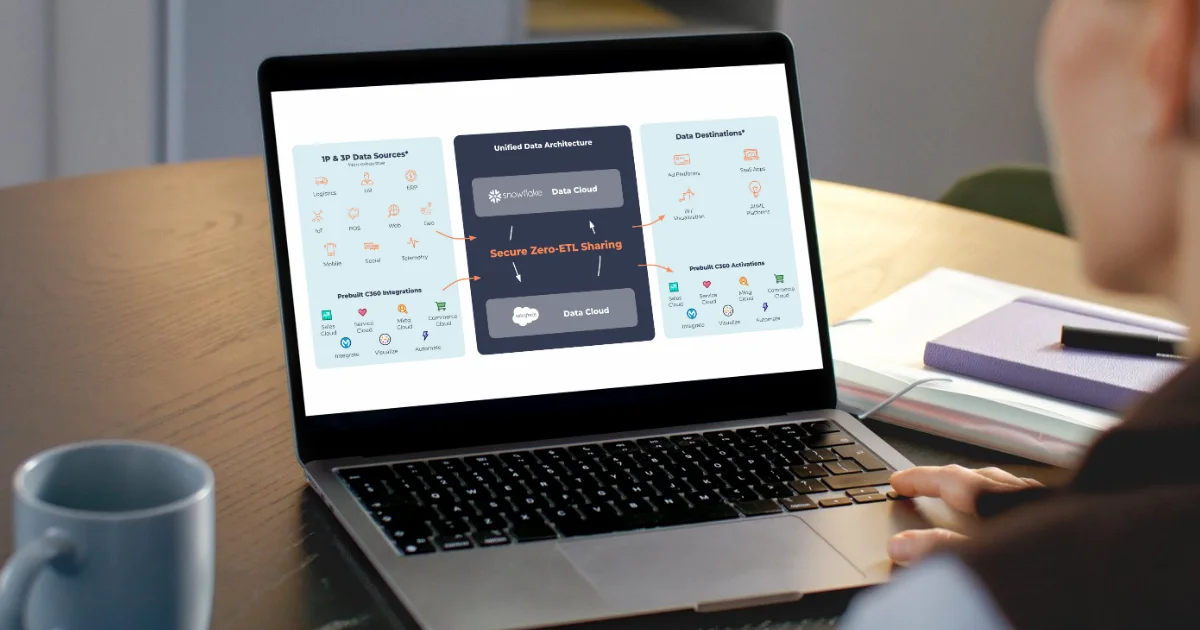Despite explosive interest in generative AI, most organizations are still struggling to turn potential into measurable performance. New data reveals where the disconnect lies—and how to fix it.
AI Ambition Outpaces Readiness: The ROI Gap
In early 2025, Coastal surveyed over 120 senior business and technology leaders from Salesforce-powered organizations. The findings reveal a stark reality: AI ambition outpaces readiness.
- 50% say they’ve seen no measurable ROI from AI investments
- Only 21% report proven outcomes
- Yet 67% of organizations plan to maintain or increase AI spending in 2025
Most companies aren’t lacking capability; they’re held back by outdated infrastructure, disconnected workflows, and AI initiatives that aren’t tied to ROI.
The Environment Is the Barrier
The main obstacles blocking AI success are data architecture and process design problems that prevent AI from scaling beyond pilots.
Top challenges holding back AI:
- 31% explicitly cite data integration as their biggest AI barrier
- 23% point to data readiness or quality as a top concern
- 1 in 5 say legacy data architecture prevents them from scaling AI
- Less than 1 in 5 organizations have a modern data foundation
The real barriers to AI are how initiatives are scoped, structured, and connected to value.
Goodbye Digital Transformation—Hello Data & AI Modernization
The Digital Transformation Era has ended, and the Data & AI Modernization Era is here. This shift goes beyond adding new tools to changing how systems work together.
This shift requires a new approach because:
- AI capabilities are real, but impact depends on whether your systems are connected and designed to support scale
- Proving capability isn’t the same as proving business value
- Organizations need to move from pilot mentality to operationalizing AI for measurable ROI
The strategy gap reveals the urgency: Companies with clear data & AI roadmaps are 2.7x more likely to report positive ROI, yet 64% still don’t have one.
Get Your Processes Agent-Ready or Get Left Behind
AI can move fast, but legacy processes can’t. Most business workflows were built for human involvement and manual handoffs. They weren’t designed for autonomous action, and now those processes risk becoming a constraint.
Why organizations are investing in AI:
- 38% to reduce manual work and improve efficiency
- 15% to improve forecasting and decision-making
- 12% to improve sales cycles
- 9% to deliver targeted experiences
The issue isn’t agent capability—it’s how work is structured. Most organizations are inserting AI agents into existing workflows, not rethinking how work gets done. That’s not modernization. It’s maintenance.
Salesforce Rebuilt Its Core—That Changes Everything
Salesforce is in the middle of a major platform evolution that goes beyond new features and upgrades. They’re structural shifts:
- Data Cloud creates unified customer profiles that drive intelligent workflows
- Agentforce delivers AI-powered automation that learns and adapts
- Embedded Analytics bring insights directly into everyday work processes
Glimmers of success are emerging: unified profiles, embedded insights, and automated workflows. But realizing that value isn’t automatic—you have to update your platform infrastructure to take advantage of it.
What To Do: Turn Potential Into Impact
Based on survey findings and Coastal’s work with AI-forward enterprises, here’s how to bridge the gap between AI investment and business impact:
Build a Data Foundation That’s Ready for Real-Time AI
- Migrate off SQL server—traditional databases can’t support real-time AI
- Modernize data infrastructure and methods across three layers: storing, transforming, and activating data
- Adopt a data-as-a-product approach by standardizing domain-driven models for AI-ready decision-making
Get Your Processes Agent-Ready
- Identify where agents will hit friction and why—look for dependencies, exceptions, or approval flows that may slow execution or block autonomy
- Eliminate steps that were built around human limitations, not business value
- Rethink how work is orchestrated across people and systems—design for hybrid execution where agents, humans, and systems play to their strengths
Turn AI Pilots Into Business Impact
- Identify high-frequency, high-cost activities—focus on where time and resources are being spent, especially in transactional, repetitive work
- Define success in business terms—align early with stakeholders and establish clear outcomes, not just technical KPIs, but business-level and experience-level impact
- Design with measurement in mind—build for transparency from day one; if you can’t measure it or show what improves, it’s not likely to scale
Modernize Your Salesforce Platform for Intelligence at Scale
- Modernize your Salesforce data footprint—adopt Data Cloud, Agentforce, Tableau Next, and MuleSoft
- Migrate off legacy, disconnected clouds—move off CPQ, legacy Marketing Cloud, and CRM Analytics
- Prepare for an API-led, data-first architecture to support cross-platform interoperability for AI at scale
The Time to Modernize Isn’t Next Year—It’s Now
The promise of AI is no longer hypothetical. But impact still hinges on modernizing the foundation beneath it: how your organization builds its architecture, rethinks its processes, and connects every data and AI initiative to measurable business outcomes.
That’s what separates early pilots from lasting performance. It’s what turns one-time wins—like unified profiles, embedded insights, and automated workflows—into everyday capability.
Going forward, companies will compete on their ability to turn AI investment into impact. The differentiator isn’t who’s experimenting with AI—it’s who’s modernizing the foundation that enables AI to deliver real business value.
Organizations that act now will be positioned to lead with AI-driven experiences, data-powered decisions, and automated operations. Those who delay risk falling behind competitors who are already building the infrastructure for future-proofed AI performance.
This analysis incorporates insights from Coastal’s Future Readiness Survey, administered by BlueWhale in early 2025, capturing responses from over 120 senior business and technology leaders—all from organizations using Salesforce. Access the full report here.



